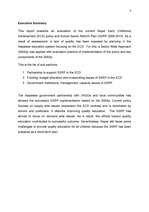· References
· Aide Memoire (2011). Joint Annual Review of the SSRP
· Asia South Pacific Association for Basic and Adult Education (ASPBAE) (2010). Exploring Partnerships for Education for All: A study on the Sector Wide Approach (SWAp) in Nepal
· Bhatta and Saurav, D. (2014). Nepal - Nepal: School Sector Reform Program : P113441 - Implementation Status Results Report : Sequence 07. Washington, DC: World Bank. [Online],
· Available at: http://documents.worldbank.org/curated/en/2014/01/18783099/nepal-nepal-school-sector-reform-program-p113441-implementation-status-results-report-sequence-07
· Boesen, N. and Dietvorst, D (2007). SWAPs in motion, Sector wide approaches: From an aid delivery to a sector development perspective, Brussels, Europe Aid, reflections from the Joint Learning Programme on Sector Wide Approaches
· Brown, A. and Foster, M. and Norton, A. and Naschold, F. (2001). The status of sector wide approaches, Working Paper 142, Overseas Development Institute, London, UK
· Cassels, A. (1997). A guide to sector-wide approaches for health development: concepts, issues and working arrangements, WHO
· CERID (2002). Journal of Early Childhood Development, vol. 5, Tribhvan University, Research Centre for Educational Innovation and Development (CERID), ECD Resource Centre, Balkhu, Kathmandu, Nepal
· CERID (2009). Journal of Early Childhood Development, vol. 5, Tribhvan University, Research Centre for Educational Innovation and Development (CERID), ECD Resource Centre, Balkhu, Kathmandu, Nepal
· Depart of Education (2012). Flash report 2012-13, Ministry of Education, Government of Nepal, Sanothimi, Bhaktapur
· European Commission (2012). Action Fiche for Nepal, [Online],
· Available at: http://ec.europa.eu/europeaid/documents/aap/2012/af_aap_2012_npl_p2.pdf
· Government of Nepal, Ministry of Education (2009a). School Sector Reform Program FY 2009-10 to FY 2015-16, Annual Strategic Implementation Plan and Annual Work Plan and Budget, Fiscal Year 2009-010, Draft, Sanothimi Bhaktapur, Nepal
· Government of Nepal, Ministry of Education (2009b). School Sector Reform Plan 2009-2015, Vol.1, Kathmandu, Nepal
· Government of Nepal, Ministry of Education, Depart of Education (2010). School Sector Reform Plan (SSRP), Status Report, Bhaktapur, Nepal
· Government of Nepal (2012). Final Mid-Term Evaluation of the School Sector Reform Program, Vol.1, Evaluation team
· Hussain, M. (2013). SWOT Analysis of MA Educational Planning and Management Programme of Allama Iqbal Open University, Turkish Online Journal of Distance Education, Vol. 14 (3), 8, Pakistan
· Institute for Health Sector Development (IHSD) (2003). Sector Wide Approaches in Education
· [Online], Available at: http://miyaichi.up.seesaa.net/image/IHSDsynthesis-rev5B15D.pdf
· Ravens, J. V. (2009). Early Childhood Development in Nepal: Expansion, Inclusion, Quality, A study to support the further development of Nepal’s national policy for early childhood, the Department of Education of Nepal and the National Office of UNICEF in Kathmandu, Nepal
· Keshab D. T. (2007). Voices of Rural Women in Nepal: Impact of Literacy on the Lives of Women, UMI, pp199
· Ministry of Finance (2010). Joint Evaluation of The Implementation of the Paris Declaration, PHASE 2: Nepal country evaluation, Singhdurbar, Kathmandu, Nepal
· Nepal Living Standards Survey (2010-2011). Statistical Report, Vol.1, Central bureau of statistics, National Planning Commission Secretariat, Government of Nepal, Thapathali, Kathmandu, Nepal
· Robert, G. Myers (2006). Quality in program of early childhood care and education (ECCE), UNESCO
· Sushan Acharya (2007). Social Inclusion: Gender and Equity in Education SWAPs in South Asia, Nepal case study, UNICEF Regional Office for South Asia (ROSA), Kathmandu, Nepal
· The World Bank (2009). Project Appraisal Document on a Proposed Credit and Grant in the amount of SDR 46.1 million and SDR 37.7 million respectively to Nepal for a School Sector Reform Program, Human Development Sector Unit, South Asia Region, The World Bank.
· Tuladhar, G. (2011). Status of Education in Nepal and Development Plan, Former Minister for Education, Nepal [Online],
· Available at: http://web.isc.ehimeu.ac.jp/ice/61@Gangalal%20Tuladhar_text%20_8p.pdf
· UNESCO (2006). Nepal Early Childhood Care and Education (ECCE) programmes, UNESCO International Bureau of Education (IBE), CP, 59, Geneva, Switzerland
· UNESCO (2007a). Strong Foundations: Early Childhood Care and Education, UNESCO, France
· UNESCO (2007b). Education Sector Wide Approaches (SWAps): Background, Guide and Lessons, Education Policies and Strategies, 12, Paris, UNESCO, France
· UNESCO (2008). Early Childhood Policy Review in Nepal (A Study Report), UNESCO Kathmandu Series of Monographs and Working Papers, No 15, Lusha Press, New Baneshwor, Kathmandu, Nepal
· UNESCO (2012). EFA Global monitoring report, [Online],
· Available at: http://www.unesco.org/new/en/education/themes/leading-the international-agenda/efareport/
· UNICEF (2000). Defining Quality in Education, Working Paper Series, Education Section, Programme Division, UNICEF, New York, USA
· UNICEF (2011). Evaluation of UNICEF’s Early Childhood Development Programme with focus on government of Netherlands Funding 2008-2010, Global Synthesis Report, UNICEF, New York, USA
· United Nations Development Programme's Human Development Report (2013).
· [Online], Available at: http://hdr.undp.org/en/statistics/hdi
· Wang, K. C. (2007). A process of SWOT Analysis, National Taipei University, Taiwan, R.O.C

